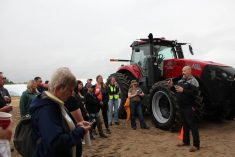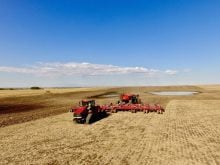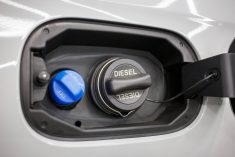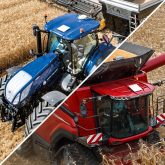There’s lots of talk these days around the “connected farm” and the growing slate of tools to help producers boost productivity, increase efficiencies and reduce risks on their farms.
An important aspect of this technology is IoT or internet of things. IoT allows interconnected devices to measure many kinds of agronomic variables and relay this information to farmers quickly so they can make better decisions.
One of the companies leading the IoT wave is Metos Canada, which offers subscription packages for farmers built around wireless IoT devices, such as sensors, soil probes and in-field weather stations, and the integration of hardware and software technology.
“IoT impacts all aspects of agriculture,” says Guy Ash, an agrometeorologist and the global training director for Metos. “The market certainly has increased, and it continues to increase at a rapid rate. There are more new sensors coming out literally each day.”
No farm is the same, of course, which is why Metos offers a wide slate of subscription packages catering to different farmer needs — everything from monitoring crop staging, assessing disease risk and pinpointing spray windows to remote monitoring of insect pressures and rapid nutrient analysis.

Ash says the reason for so many Metos offerings is to provide flexibility for farmers. “We like to look at it in terms of a nested approach for any typical farm operation, not just one size fits all.”
Subscription packages are as follows:
- FieldEssentials includes the iMetos LoRain weather station, which is designed to monitor precipitation, temperature, relative humidity and calculated leaf wetness. The starting price is $400 per year for a 36-month term.
- MicroFarm includes the Micro iMetos weather station, which is designed to monitor precipitation, temperature and relative humidity. It can be expanded with additional sensors including soil moisture, temperature and salinity probes. The starting price is $900 per year for a 36-month term.
- MicroPro includes the Micro iMetos weather station, which is designed to monitor precipitation, temperature, relative humidity, calculated leaf wetness, ultrasonic wind speed and wind direction. It can be expanded with additional sensors including soil moisture, temperature and salinity probes. The starting price is $1,300 per year for a 36-month term.
- FieldBasic includes the iMetos Eco D3 weather station, which is designed to monitor precipitation, temperature and relative humidity. It can be expanded with additional sensors including soil moisture, temperature and salinity probes. The starting price is $900 per year for a 36-month term.
- FieldPro includes the iMetos Eco D3 weather station, which is designed to monitor precipitation, temperature, relative humidity, calculated leaf wetness, solar radiation, ultrasonic wind speed and wind direction. It can be expanded with additional sensors including soil moisture, temperature and salinity probes. The starting price is $1,550 per year for a 36-month term.
- WeatherPro includes the iMetos 3.3 weather station, which is designed to monitor precipitation, temperature, relative humidity, calculated leaf wetness, solar radiation, ultrasonic wind speed and wind direction. It can be expanded with additional sensors including soil moisture, temperature and salinity probes. The starting price is $2,100 per year for a 36-month term.
Read Also

Claas brings 1000 Series SP forage harvesters to Canada
In mid-August, Claas unveiled its new line of Jaguar forage harvesters at an event in Visalia, California, deep in the heart of that state’s dairy region.
These packages can be upgraded to include site-specific forecasts and iMetos work-planning tools ($295 per year) or single crop disease modelling ($150 per season).
Also available is iScout, a pest detection device for farmers that uses artificial intelligence and a high-resolution camera inside of an insect trap (multiple types are available) to identify and track problem bugs. It costs $1,000 per year.

CropView is another Metos offering that enables farmers to monitor their crops remotely via a high-resolution camera. Equipped with wide angle and telephoto lenses, the camera can provide panoramic views of a field and can zoom into specific areas within the crop canopy. The cost is $1,400 per year.
Metos has a mobile soil lab as well. The iMetos Mobilab uses capillary electrophoresis to analyze nutrients in a soil or plant sample, with the data logged to GPS co-ordinates within a field to facilitate variable-rate applications. Results are ready in as little as three hours, and you don’t need laboratory training to operate the device.
Real-time data
All of the IoT instruments and devices are designed and built by Pessl (a sister company to Metos) and the information they produce is uploaded to the Metos FieldClimate platform (available through the website and an app). Users can access the data almost immediately, resulting in less risky and more efficient crop management.
“The idea here is the data is transmitted in near-real time, so you have near-real-time information flow to you as an agronomist or farmer,” says Ash. “You’re reacting to issues as they actually happen, if you can.”
Ash sees IoT technology, by enabling farmers to make better decisions and make them more quickly, as a sound investment that can reap returns in the neighbourhood of three and even four to one.
“What we’re trying to do here is shave risk. We’re not going to eliminate risk, but we’re shaving percentages of risk off. When you do that over an entire farm production system, that’s a lot of money saved in a given year by applying those tools across the farm,” he says.
Ash says he believes there’s a value proposition for in-field IoT solutions and sensors that lead to specific, actionable work-planning tools farmers can use all season long to inform their agronomic decisions.

The Metos FieldClimate platform, for example, features a stoplight system (green for go, yellow for caution, red for stop), which helps with questions like whether a field is too wet for accessibility, is there a danger of spray drift happening, or are soil temperature and moisture right for germination?
“In the end, for the customer, it’s about, ‘What do I get with this thing? I don’t want more data. I’m sick of data. I simply want an answer to a particular problem in front of me,’” says Ash.
The Metos weather stations can be linked with up to 400 different sensors, providing a rich source of data Ash says can be tailored to address specific issues farmers face.
“Really, it’s about customization of what’s required for the particular application,” says Ash. Disease management, rainfall, temperature, humidity and leaf wetness are the key variables to consider, he says. Wind speed, temperatures and solar radiation are what’s needed to measure evapotranspiration, while irrigation management requires evapotranspiration estimates, rain buckets and multiple soil probes within a field.
“We can improve the yields by giving the crop the best start possible through these devices. You can also use it to look at things like fertility. When should we top up our nitrogen, for example, if you’ve got good moisture, or when should we spray to control insects or diseases? All of these things are possible when we have IoT devices within the field.”
Soil probes
As the functionality of soil probes has increased over time, so has their value in helping farmers grow better crops and reap better yields. “These probes today have multiple sensors at multiple depths and can measure things like moisture, temperature and salinity, so you can look at the actual moisture held at each layer, including at seed depth and throughout the root zone profile, which is important for fertility requirements,” says Ash.
“It allows you to effectively know the seeding temperature for ideal seeding and germination and the moisture conditions of the seedbed for both seeding and germination, which leads to a better understanding for effective management and higher yields in the end.
“We know each inch of moisture equates to so many bushels of yield per crop. In wheat, it’s seven and a half to eight, or corn it’s 10 to 12 bushels for each inch of water. With a probe alone, we’re getting some extremely valuable information … and we can make a very good estimate of what you have in the bank for your yield estimate.”
Ash maintains digital agronomy, essentially the merging of IoT technology and traditional agronomy, saves farmers time and money by reducing trips to the field. However, he doesn’t discount the importance of boots on the ground.
“You always need to do the traditional agronomy, which is to go out to have a look and scout,” Ash says. “We provide and digest the (agronomic) information into a toolset, but we are not making recommendations in the software. You need an agronomist or an educated person that uses the information in their farm management system to make the appropriate decisions.”
















